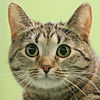Ceylon cat
| Ceylon | |
|---|---|
| allowed colors | All natural colors are recognized |
| special drawing variants of the Ceylon | Benota (ticking is evenly distributed on the back, shoulders and flanks, while the head, tail and extremities are striped and there are spots on the stomach) Chaus (even ticking, whereby the stripes are less clear) Continental (even tabby in blotched, spotted or mackerel) |
| not allowed coat drawing | Absence of tabby drawings |
| List of cat breeds | |
The Ceylon cat ( English Ceylon cat ) is a short-haired pedigree cat that comes from Sri Lanka (formerly: Ceylon) and is still relatively unknown.
history
The Ceylon cat owes its name to the island of Sri Lanka , which was formerly a British crown colony called Ceylon. There it emerged, unlike most other pedigree cats, as a natural breed without specific breeding by humans. Since only two different types of small cats live in Sri Lanka in addition to domestic cats, the pipe cat and the rust cat , the different species could have mixed up, from which the Ceylon was then formed.
In 1964, Dr. Paolo Pellegatta saw the Ceylon cat on his trip through Sri Lanka and was so enthusiastic about the breed that he took some specimens of the Ceylon with him to Italy . In the following years he kept returning to Sri Lanka to bring more cats to Italy, where they are now very popular and are bred on a club basis.
In 1984 the Ceylon was presented for the first time at an international cat show in Erba (Lombardy) and delighted the public there. The "Club Amatori del Gatto di Ceylon" (in German: Friends of the Ceylon Cat) was set up with the aim of strengthening the spread of the Ceylon cat. In 1989 the FIAF (Federazione Italiana Associazioni Feline) and a little later the WCF (World Cat Federation) officially recognized the Ceylon as a separate breed.
Appearance
The size of the Ceylon cat varies from small to medium and has a fine structure. The hind legs are usually a little longer than the front legs. Their paws are small and plump. Their tail is relatively short and is slightly wider at the base than at the rounded tip.
The Ceylon head is large and has protruding cheekbones. The nose is relatively long and has a slightly suggested stop . In proportion, their ears appear relatively large. They stand close together and sit high on the head. She has large, widely set eyes that are almond-shaped, their color varies from yellow to green. The basic coat color is agouti with tabby stripes on the legs as well as on the tail and face. The clear M pattern on the forehead is also very characteristic of the Ceylon cat. Overall, the males are built a little stronger than the females.
behavior
The Ceylon is a very active cat that is considered to be particularly affectionate and sociable. She is also very adaptable and is friendly towards strangers. She usually gets along well with other pets or conspecifics, especially if they grew up together. Since the Ceylon is very lively, owners should make sure that it gets enough exercise. If the apartment is large enough and has a cat-safe balcony, the Ceylon does not necessarily need access to the outside due to its adaptability.
